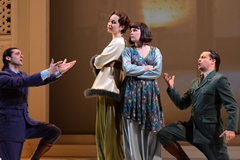| Opera Reviews | 13 May 2024 |
Seraglio only occasionally shinesby Steve Cohen |
|
| Mozart: Die Entführung aus dem Serail Opera Company of Philadelphia February 2012 |
|
|
The German title, Die Entführung aus dem Serail, is hard enough for American audiences to grasp, and the English-language alternative is not much better. "Rescue from a Harem" would be more understandable. Obsession with strange people from the Middle East was rife when Mozart was a young man. Muslim countries employed sea pirates and Europeans were afraid that Turks and Arabs would enslave, rape and murder Christians. In this atmosphere, audiences attended many plays and even an earlier opera by Wolfgang, Zaïde, on that subject. Director Robert B. Driver changed the time period from the late 1700s to 1918 and he designed the production to resemble movies from the 1920s that dramatized the closing days of World War I. During the overture and opening scene, black-and-white movie clips (including Wings and Mata Hari) gave us a good sense of time and place. It was Istanbul, capital of the Ottoman Empire, an ally of Germany in the war, where an American spy was captured by the Turks and an Allied flying ace came to her rescue. Seraglio was unique because Mozart turned away from the Italian language to write a sung-and-spoken comedy in his native German. It also provided a musical milestone when Mozart wrote a precociously-mature dramatic soprano aria for the leading lady, "Martern aller Arten" ("Tortures of all kinds"). Although the opera's musical/historical aspects are significant, Seraglio's success ultimately depends on vocal excellence. Especially from the heroine, Konstanze, who needs to have superstar qualities. The Opera Company of Philadelphia cast Curtis student Elizabeth Zharoff in that role. Mozart shattered the conventions of his time with the length, range and complexity of "Martern aller Arten," accompanied by four solo woodwinds and orchestra. The woman sings how she risks everything and even is willing to die. Zharoff sang it musically enough, but the scene came through as a coloratura showpiece rather than a dramatic one. Her voice also lacked resonance in the crucial low F-sharp where Konstanze sings about death. In her spunky demeanor she resembled Mary Tyler Moore (from the movie version) or Sutton Foster (from the stage version) of Thoroughly Modern Millie. Her love interest was a light-voiced Spanish tenor, Antonio Lozano. Elizabeth Reiter was the petite and charming soubrette called Blonde. Per Bach Nissen, a Danish bass, was excellent as Osmin, the Turkish overseer of the harem. Krystian Adam was the exuberant second tenor while Peter Dolder was a bland Selim. It is impossible to take the plot seriously, because audiences are asked to accept the plausibility that the dictator in an evil empire would have two female captives in his harem and allow them to spurn his sexual advances. This production mitigated that idiocy, to some extent, as Driver likened the character Selim to the supposedly-progressive Mustafa Ataturk, who was a Turkish military leader in the war and then helped found the modern Turkish republic. That was adroit, but it actually ran counter to the opera's premise. Audiences wanted (and Americans and Europeans may still want today) to see the dark-skinned Turk as rapacious and thoroughly evil. And, after all, Ataturk was accused of perpetrating genocide against Armenians. Driver's staging of the big soprano number was clever. Selim retreated into the auditorium so that Konstanze was able to face him directly while simultaneously singing to the audience. Throughout, Driver made good use of ramps to provide varied entrances to the stage. Aside from the movie projections, however, the large stage often looked empty, with virtually no scenery. Corrado Rovaris led a crisp reading of the orchestral score which incorporates some Turkish-sounding instruments such as bass drum, cymbals, triangle, and piccolo. |
|
| Text ©
Steve Cohen Photo © Opera Company of Philadelphia |

 The
Abduction from the Seraglio has historical and musical significance.
But does it make much impact on audiences in 2012? This production by
the Opera Company of Philadelphia was only partially successful.
The
Abduction from the Seraglio has historical and musical significance.
But does it make much impact on audiences in 2012? This production by
the Opera Company of Philadelphia was only partially successful.





